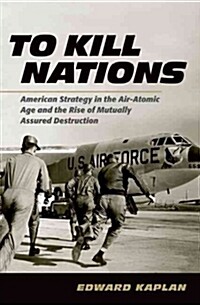
To Kill Nations: American Strategy in the Air-Atomic Age and the Rise of Mutually Assured Destruction
- 개인저자
- Edward Kaplan
- 발행사항
- Ithaca: Cornell University, 2015
- 형태사항
- viii, 260 p. ; 25 cm
- ISBN
- 9780801452482
- 청구기호
- 392.1 K17t
- 서지주기
- Includes bibliographical references (pages 229-252) and index
소장정보
| 위치 | 등록번호 | 청구기호 / 출력 | 상태 | 반납예정일 |
|---|---|---|---|---|
이용 가능 (1) | ||||
| 1자료실 | 00016894 | 대출가능 | - | |
- 등록번호
- 00016894
- 상태/반납예정일
- 대출가능
- -
- 위치/청구기호(출력)
- 1자료실
책 소개
Between 1945 and 1950, the United States had a global nuclear monopoly. The A-bomb transformed the nation's strategic airpower and saw the Air Force displace the Navy at the front line of American defense. In To Kill Nations, Edward Kaplan traces the evolution of American strategic airpower and preparation for nuclear war from this early air-atomic era to a later period (1950-1965) in which the Soviet Union's atomic capability, accelerated by thermonuclear weapons and ballistic missiles, made American strategic assets vulnerable and gradually undermined air-atomic strategy. The shift to mutually assured destruction (MAD) via general nuclear exchange steadily took precedence in strategic thinking and budget allocations. Soon American nuclear-armed airborne bomber fleets shaped for conventionally defined--if implausible, then impossible--victory were supplanted by missile-based forces designed to survive and punish. The Air Force receded from the forefront of American security policy.
Kaplan throws into question both the inevitability and preferability of the strategic doctrine of MAD. He looks at the process by which cultural, institutional, and strategic ideas about MAD took shape and makes insightful use of the comparison between generals who thought they could win a nuclear war and the cold institutional logic of the suicide pact that was MAD. Kaplan also offers a reappraisal of Eisenhower's nuclear strategy and diplomacy to make a case for the marginal viability of air-atomic military power even in an era of ballistic missiles.
--James Wood Forsyth, Jr., School of Advanced Air and Space Studies "H-NET Reviews"
